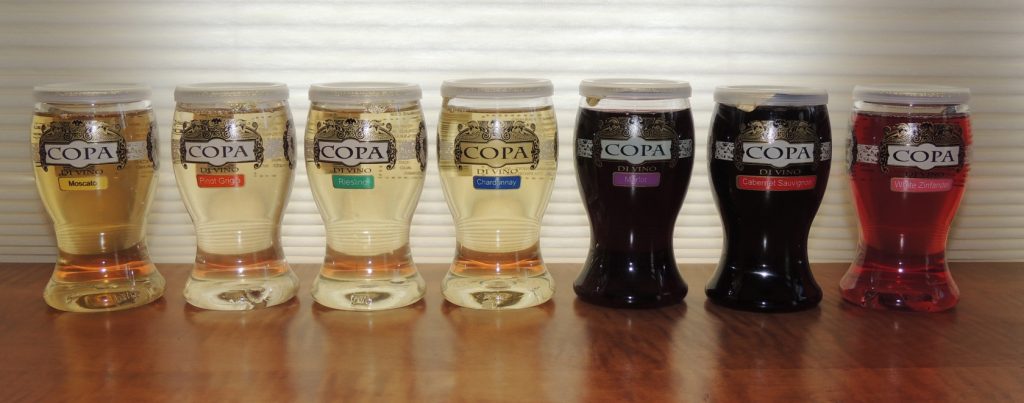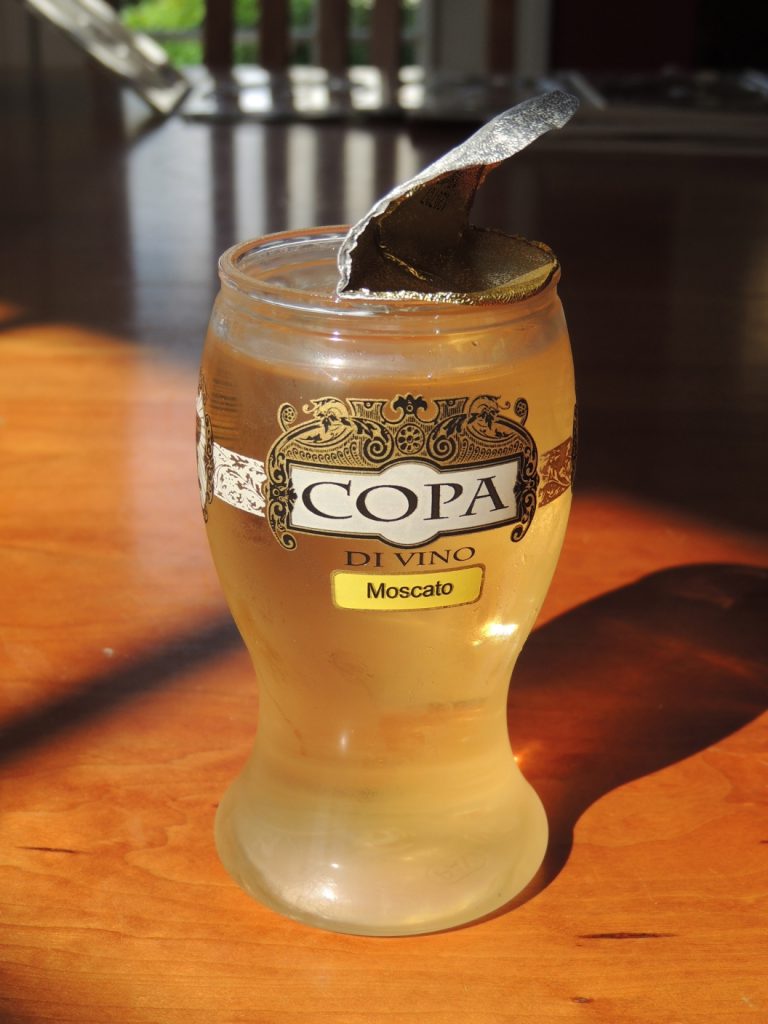Copa di Vino: A Review
So there I was . . . saving money and living better at WalMart, when I rounded the cereal aisle and ran straight into this: Copa di Vino.
Copa di what?
Copa di Vino . . . Cup ‘o Wine.
And now Barry Manilow is singing in my head. At the Copa . . .
What Is Copa di Vino?
It’s a clever idea. We have single serving beer, why not single serving wine?
But the critical question and bottomline for any wine lover/connoisseur/snob/brat is this: Is the wine any good?
Will I want to smuggle an armful of them into a hockey game, concert, or a PTA meeting at the bottom of my purse?
After investing in the entire Copa lineup ($21 for all 7 flavors), I came home and started doing a little research.

Copa di Vino’s Founding
Copa di Vino was founded by entrepreneur James Martin. Long story short: Inspired by single-serve wines he spotted while riding a bullet train in France, Martin eventually partners with Pascal Carvin (the original inventor/bottler), and Copa di Vino is born.
Martin (and Copa di Vino) appeared on the television show, Shark Tank. Twice. And twice Martin rejected offers from the Sharks. Once because the investor shark was only interested in the single-serve technology (not the wine), and Martin didn’t want to separate the two.
Martin thought the second offer was a low ball offer, so off he went without an investor shark.
BTW, the Sharks tried the Copa di Vino wines. Their faces looked like they had just ingested battery acid. One of the Sharks said, “Don’t come and tell me this is premium wine. It’s not. It’s just industrial wine.” Ouch. Is it that bad?
Copa di Vino’s Premium Blend
Copa’s Facebook page says Copa is “a brilliantly simple idea of bottling premium wine directly into a glass”. There’s that word again. Premium.
But I’m having fits trying to figure out who makes the premium wine that goes into the Copa cups. The Moscato and Merlot Copas say “Product of Chile” and the remaining Copas all say “Columbia Valley”.
Beyond that, the information seems to be a corporate secret. Seriously. The recipe for Coca-Cola is less of a mystery.
I sent two emails to Team Copa inquiring about the wine in the Copa cups.
And I got two quick responses in return.
One said, “I’m sorry, but we can’t disclose that information”. The other said all Copa Di Vino wines are made at The Sunshine Mill (Copa’s headquarters), using juice they import from Chile (for the Moscato and Merlot), or with local juice from the Columbia Valley for the other wines in the Copa lineup.
So I still have no idea where in the Columbia Valley and Chile the “juice” is coming from. I understand proprietary trade secrets. Really, I do. But it doesn’t mean I’m not frustrated. Really frustrated.
Copa di Vino Tasting Notes

Here’s the entire Copa di Vino lineup . . . Let the tasting begin!
I’m told that all the Copa di Vinos lined up like this look like urine samples.
And someone is badly dehydrated. I’d tell him that’s a horrible thing to say . . . if it weren’t a little bit true. And a little bit funny.
General observations about the Copa cups:
- Each Copa is 187ml, which is 6.32322 ounces.
- The Copa is a very sturdy, glass-mimicking plastic. It feels like glass in your hand.
- The foil closure reminds me of the Jello you get in a hospital.

Disclaimer: I tasted the Copa line-up, and I was disappointed. For the sake of scientific inquiry, and to make sure I wasn’t having a warped-palate day, I phoned a friend to come over and give her opinion.
What follows is a mash-up of our tasting notes.
Copa di Vino Moscato
The nose is benign. Dried, candied pineapple. A very sweet wine with little balance, it’s cloying. Reminds me of fruit cocktail syrup (which I love under normal circumstances). It’s basically a high-octane juice box. But I can see folks who like sweeter wines enjoying this.
Copa di Vino Pinot Grigio
Smells like absolutely nothing. Wait. As it warms up, it smells like the cheese department at the grocery store (which is not a bad thing). Flavor is a tart green apple with herbal notes. And a weird metallic finish. Seriously. Like chewing on aluminum foil. Could not stand that part.
Copa di Vino Riesling
Again, this smells like nothing, and definitely not like Riesling. No petrol, no wet stones. Starts sweet and finishes like one of my daughter’s Sour Patch Kid candy. Tastes like Crystal Light white grape juice. But my husband says this is his pick of the litter.
Copa di Vino Chardonnay
I could actually identify this as a Chardonnay. Definitely oaky, though. For me, the most drinkable of the bunch.
Copa di Vino Merlot
This is an angry wine. It smells like an ashtray. Maybe an ashtray with a blackberry in it. It definitely tastes like an ashtray. (Hey, I went to college, I have ashtray experience). Wow.
Copa di Vino Cabernet Sauvignon
I watched a couple of guys on YouTube say they were “delighted” with this wine. Delighted? I don’t get delighted. It smells a high school weight room. And there’s nothing delightful about a high school weight room. My husband said the difference between this wine and motor oil is that he could drink motor oil if he really had to.
Copa di Vino White Zinfandel
I saved this for last because I hate White Zinfandel. It doesn’t matter who makes it or how cute the cup is . . . it’s awful. And I didn’t want to wreck my palate upfront. Surprisingly, I don’t dislike this as much as I do the Merlot and the Cab. It just tastes like rotten guava juice.
Copa di Vino Final Tasting Notes
Here’s the deal. From a cost perspective, this Copa wine-up is essentially a $12 bottle of wine. But you’re paying for cuteness and convenience, so I suspect this is more like a $4 bottle of wine. Set your expectations accordingly.
The cups are clever . . . but the wine is plonk. I wish I had better news for you.
You should 100% be choosing wine in a can over this.
Copa di Vino FAQ
How much was Copa di Vino acquired for?
Copa di Vino acquisition was acquired by SBEV for a total of $5,980,000 in addition to assuming certain liabilities, will mark the addition of a fourth premium brand to Splash Beverage’s portfolio.
Did Copa di Vino get a deal on Shark Tank?
The prepacked wine-by-the-glass didn’t land a deal with the sharks, but it did land him a two-year prison sentence and $1.8 million in restitution payments. One of the wine’s distributors took the Shark Tank fame and ran with it—using Copa di Vino’s reality show cred to secure his own investors for over half a million dollars, according to the Department of Justice.









